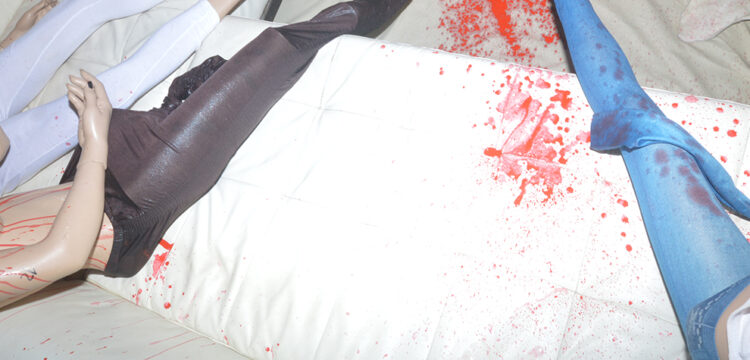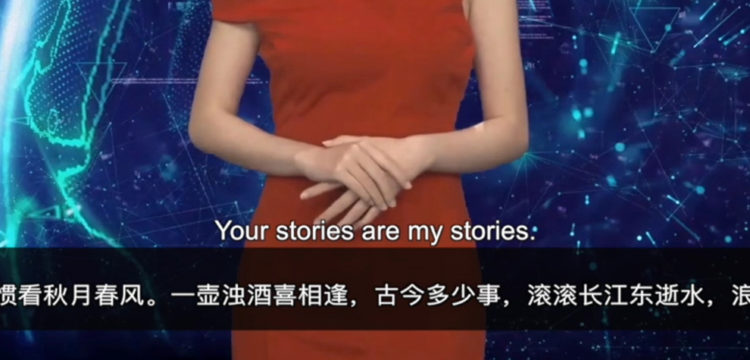Humans are Due to Expire Soon
The purposeless existence of the human being
WARNING!
The following document contains explicit content against humans. Individuals may be subject to humiliation, embarrassment or shame.
Through the following document I will elucidate a critique on the human being. I will defend its loss of originality and individuality, defined by its purposeless existence in a world of artificial disembodiments. Through exhaustive systems of mechanical reproduction, human beings (to be consumed preferably soon) have condemned themselves to their own extinction.
Above is a strikingly simple screenshot-image of an artificial insemination from a video on the web, whose original author has been lost in the process of its relentless multiplication. This “poor image” has lost its quality and thus its aura. [1]
Although fragile and ephemeral, downloaded with a certain disinterest in less than a fraction of a second, this image holds an untamed force: the annihilation of homo sapiens and the species’s millennia-spanning history.
No romantic poet can defend the dubious yet miraculous procreation of man and woman after watching the 30-second YouTube video of a single diploid sperm injection into a monochromatic egg, uploaded by an unknown and untraceable online user. As the Garden of Eden is transformed into a petri dish, Adam and Eve are replaced by a pipette and an insemination gun.
In losing their generatrix and replacing it with a mechanical and artificial process, humans have lost their authorship [2] and originality. The mother, the origin, is now a machine-powered incubator. Soon we will all be copies of copies, reproducible as online images, that are available for consumption at any time and can be shared in milliseconds.
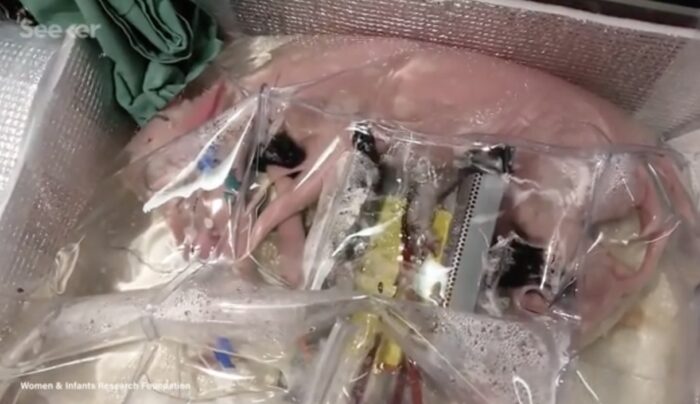
The first lab-grown lamb, which some might consider the lamb of God, contributed greatly to the destruction of the human being.
No mother, no father, no parents, no fertilization, no fertilized egg, no sperm: just a scientist and their artifact. Like a photographer with their camera, the scientist penetrates the body, assigning it the gift of life through its artificial reproduction.
The womb is now a biobag [3], where amniotic fluids are artificially transferred by plastic tubes. How can TERFs defend the idea of “woman” as uterus, when it has been cruelly replaced by a plastic bag?
After seeing garbage bags as luxury high-fashion accessories, in the near future we will see artificial wombs as wearables.
Not only has artificial science dismantled gender, sexuality, and race, but the Internet itself and its virtual reality are unquestionably revolutionizing any certification of humanity. Although this may sound like a dystopian nightmare, contemporary thinkers like Timothy Morton, Paul Preciado or Legacy Russell already race toward new belonging and new theory. From capitalocene to chthulucene [4], new species arise while others go extinct.
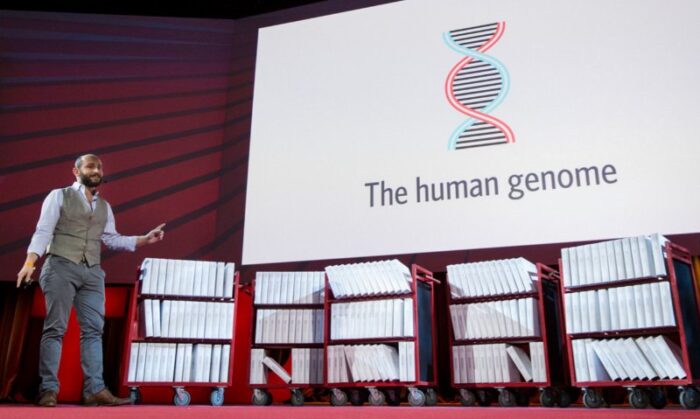
The overrated “homo sapiens” is among the species at the summit of extinction, if not already extinct. The current generations may be the last on planet Earth.
Every one of a human’s cell has billions of reproducible codes that can be downloaded, cloned, modified, edited and cut like a Photoshop image—it’s called DNA.
Because of their limited ability to decipher human DNA, scientists have begged the help of technologies to complete the sequencing of the human genome. Our code is so long that no human would be able to read it in a single lifetime. Computers, having cracked the complete code, can now do it in a matter of minutes. Telomere to Telomere (T2T or TERT) is the process by which a highly sophisticated technology, used by the T2T Consortium, was able to finalize and complete the sequencing of the human genome in 2019.
Billions of letters containing genetic code have been written in dozens of books now stored in an archive. Humans “see” or rather “read” themselves through a machine, just as photographs are mechanically reproduced by escaping human vision.
In machine language, homo sapiens translates to “CHM13hTERT”, the name of a human cell designed to fully encode the 13th chromosome, telomere to telomere (T2T). Read as a code and subjugated by the artifact, humans are built into a system of letters and numbers that are unidentifiable and, above all, unpronounceable. This leads one to think about what “human” really means beyond a simple sequence of 4 letters: A,T,G,C (adenine, thymine, guanine and cytosine) combined with each other and multiplied countless times, incomprehensible without the help of a machine.
How would you feel knowing that you are being studied, analyzed, multiplied and cloned by unknown people? That your cells are for sale and your existence is reproduced in frozen capsules?
Human individuality has been hacked; its originality, privacy and identity have leaked out with uncontrollable force. The disruption of the originality and authorship of human genes is only one of the many reasons for the destruction of the human, its inability to read, understand and know itself. Hence the birth of the machine.
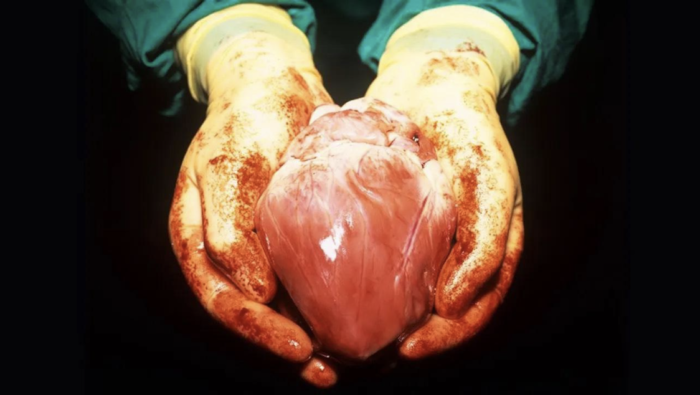
I could go on and on about the pleasant destruction of the human being, for it seems quite clear that humans are due to expire soon.
The apparatus overcomes its creator. Human hearts are pumped by the sterile gloves of doctors, who have outsourced surgery to robots.
No, not this one! This is a pig heart moments away from being implanted into a human’s body.
Curated by The Orange Garden and spazioSERRA, CHM13hTERT is a long durational performance by Agnes Questionmark proposed within unpostoIMPOSSIBILE, a season of exhibitions by spazioSERRA in which a selected artist abstracts their artistic experience from a physical space to an unplaceable “elsewhere, through a continuous dialogue between inside/inside and outside/outside.” The performance is viewable from Thursday, May 4th to Thursday, May 19th 2023 at the Lancetti station of the Milan Passante railway. Above, an essay by the artist.
[1] “This image makes it easy to comprehend the social bases of the contemporary decay of the aura. […] Namely, the desire of contemporary masses to bring things ‘closer’ spatially and humanly, which is just as ardent as their bent toward overcoming the uniqueness of every reality by accepting its reproduction.” (Benjamin, 1935)
[2] One can compare the role of humans in the era of “artificial insemination” using Walter Benjamin’s terminology on authorship and originality regarding the role of art in postmodernism: “The presence of the original is the prerequisite for the concept of authenticity.” (Benjamin: 1935)
[3] The biobag consists of a sealed bag to contain the subject, a “pump-less oxygenator circuit” and umbilical cord access. The sealed system prevents outside exposure, minimizing the risk of infection. The bag enables constant exchange of amniotic fluid, providing all necessary water and nutrients.
[4] “Making a small change in the biologist’s taxonomic spelling, from cthulhu to chthulu, with renamed Pimoa chthulu I propose a name for an elsewhere and elsewhen that was, still is,and might yet be: the Chthulucene. I remember that tentacle comes from the Latin tentaculum, meaning “feeler,” and tentare, meaning ‘to feel’ and ‘to try’; and I know that my leggy spider has many-armed allies. Myriad tentacles will be needed to tell the story of the Chthulucene.” (Haraway)
BIBLIOGRAPHY
“A Statement from Hannah Black, Ciarán Finlayson, and Tobi Haslett Regarding Warren Kanders and the 2019 Whitney Biennial” artforum.com,.
“Art as Occupation: Claims for an Autonomy of Life.” e-Flux.com, .
Ayres, Philip. “Anthony Ashley Cooper, Third Earl of Shaftesbury Characteristics of Men, Manners, Opinions, Times Lawrence Klein” Huntington Library Quarterly, vol. 64, no. 3/4, Jan. 2001, pp. 539–542, 10.2307/3817928. Accessed 23 July 2019.
Baudelaire, Charles. The Painter of Modern Life. London, Penguin, 2010.
Baudelaire, Charles, and Ed And. The Painter of Modern Life, and Other Essays, by Charles Baudelaire. Translated and Edited by Jonathan Mayne. London) Phaidon, 1964.
Campos de Camargo, André. “PRECIADO, Beatriz. Manifesto Contrassexual. São Paulo: N-1 Edições, 2014. 223 P.” Cuestiones de Filosofía, vol. 3, no. 20, 8 Aug. 2017, pp. 144–147, 10.19053/01235095.v3.n20.2017.7143. Accessed 1 Dec. 2021.
Foucault, Michel. “The Subject and Power” Critical Inquiry, vol. 8, no. 4, 1982, pp. 777–795, 10.1086/448181.
“Under the Gaze of Theory” e-Flux.com, .
“Artificial Womb Keeps Premature Lambs Alive for Weeks. Are Humans Next?” PBS NewsHour, 26 Apr. 2017. Accessed 16 Jan. 2023.
Austin, John L, et al. How to Do Things with Words, [the William James Lectures Delivered at Harvard University in 1955]. Cambridge (Ma), Harvard University, 1975.
Benjamin, Walter. The Work of Art in the Age of Mechanical Reproduction. London, Penguin Books, 1935.
Burke, Edmund. A Philosophical Enquiry into the Origin of Our Ideas of the Sublime and Beautiful. Scholar Select, 2016.
“Dizionario per Lo Chthulucene | NERO.” Not, 24 Sept. 2019, . Accessed 15 Jan. 2023.
Donna Jeanne Haraway, et al. Chthulucene : Sopravvivere Su Un Pianeta Infetto. Roma, Nero, 2020.
“HD Stock Video Footage – U.S. Landing Ship Tank (USS LST-349) Founders on Isle of Ponza, Italy” criticalpast.com. Accessed 15 Jan. 2023.
José Esteban Muñoz. Cruising Utopia: The Then and There of Queer Futurity. New York, New York University Press, 2009.
“Linnaeus and Race” The Linnean Society. Accessed 15 Jan. 2023.
Marcus, Donna. “The Artist behind the First Known Public Sculpture of a Nude Trans Body” I-D.vice.com.
Morgan, Elaine. “Elaine Morgan | Speaker | TED” ted.com. Accessed 15 Jan. 2023.
Romanis, Elizabeth Chloe. “Artificial Womb Technology and the Frontiers of Human Reproduction: Conceptual Differences and Potential Implications” Journal of Medical Ethics, vol. 44, no. 11, 10 Aug. 2018, pp. 751–755,.
Russell, Legacy. GLITCH FEMINISM : A Manifesto. S.L., Verso, 2020.
“Speculative Fabulations for Technoculture’s Generations” The Multispecies Salon, 28 Feb. 2014.
Steyerl, Hito. “In Defense of the Poor Image – Journal #10 November 2009 – E-Flux” E-Flux.com, Nov. 2009.
“The Comical Nature of Isabella Rossellini” Interview Magazine, 14 Jan. 2014. Accessed 15 Jan. 2023.




